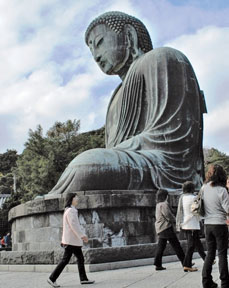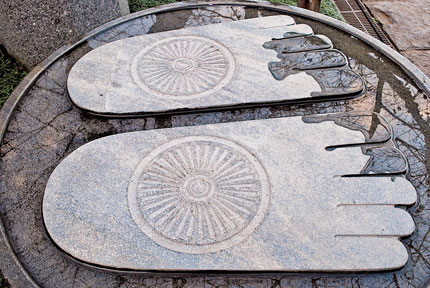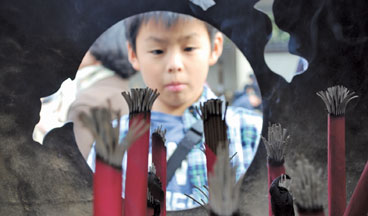Kamakura, a small city of temples
Text and pix by Chandani Jayatilleke
|

Kamakura Buddha statue
|
Kamakura is a small, historical city, 50 kilometres south of Tokyo,
which promises temples, forests, hiking trails, craft shops and a
beautiful view of the beach on the Pacific coast. It's a day trip from
Tokyo, and takes less than an hour by Shinkansen - the bullet train.
We boarded a train from Tokyo Central and got off at Kita-Kamakura to
begin our journey. There were plenty of temples to choose from, but we
started with the Kotoku-in Temple.
The biggest draw in Kamakura is undoubtedly Daibutsu - the big bronze
Buddha statue on the grounds of the Kotoku-in Temple.
The statue also known as the Amida Buddha (amitbha in Sanskrit)
stands at 13.5 metres tall, cast in bronze and weighs around 120 tons.
It is an amazingly beautiful statue, symbolising the perfections of
the Buddha - his purity, compassion and wisdom.
 |
| |
 |
| A carving of
the feet of the Buddha |
 |
| A child lights
incense sticks in front of the Daibutsu |
Despite the crowded surroundings, one can totally and easily immerse
in the feeling of serenity; there's nothing but peace and quietness in
the environment. Historical evidence says it was originally housed in a
building with a roof, until a tsunami destroyed the building in 1495,
leaving the statue exposed to the elements.
The statue now located in the middle of a courtyard is hollow.
Visitors are allowed to enter through the back door for a small fee and
we followed the others queuing to enter. One could notice the welding
work; and get a better idea on how it had been built.
It is believed the construction work of the Buddha statue began in
1252 and continued for about 10 years.
The costs were met by the priest Joko, who successfully persuaded
members of the community to make donations.
Among the records of the temple the name of Hisatomo Tanji appears as
a craftsman responsible for the casting of the Daibutsu and a man known
as Gorouemon Ohno appears in the temple lore, but the designer of the
original model and many other details surrounding the construction
remain unknown to this day.
It is thought the hall which houses the Buddha statue was destroyed
twice by strong winds and tidal waves in 1334 and 1369. Records are not
clear for the intervening period but it was not rebuilt again after the
15th century.
Maple trees
A few feet away from the compound is a wonderful garden area, in
which we noticed some maple trees with their leaves just turning bright
yellow and orange; a feast for the eye. Kamakura is an ideal place for
those who wish to walk, climb thousands of temple steps and catch a
glimpse of authentic Japanese lifestyles.
Thousands of visitors throng here - almost every day and we were told
it is a popular spot for autumn colours, which usually reach their peak
around early December. The temple entrance surrounded by many cherry
blossom trees (sakura flowers), is a particularly popular photo object
during the flowering season.
Our next stop was Engakuji, one of the five Zen Buddhist temples in
the area.
The temple was founded in 1282 by a Chinese Zen monk at the request
of the then ruler of Japan, the regent Hj Tokimune after he had repelled
a joint Mongolian-Korean invasion in the period 1274 to 1281. Tokimune
had a long-standing commitment to Zen and the temple was intended to
honour those of both sides who died in the war, as well as serve as a
centre from which the influence of Zen could be spread.
Engakuji has two national treasures; the great temple bell and the
Shariden shrine. It is a beautifully designed hall in which, the
Japanese believe, a tooth of Buddha is enshrined. It is designated a
national treasure, but can only be seen from a distance during most of
the year.
The site also has a popular tea house, where visitors can enjoy a cup
of tea, amazake (sweet sake) or Japanese sweets.Hasedera is another
beautiful temple built along the slope of a wooded hill.
To reach there, one has to climb stairs and is quite exhausting. But
a visit to this architecturally rich site is well worth. Along the way
stands the Jizo-do Hall with hundreds of small statues of the Jizo
Bodhisattva. We left Hasedera as darkness fell and walked along with the
crowd back to the railway station to catch a train to Tokyo. |


